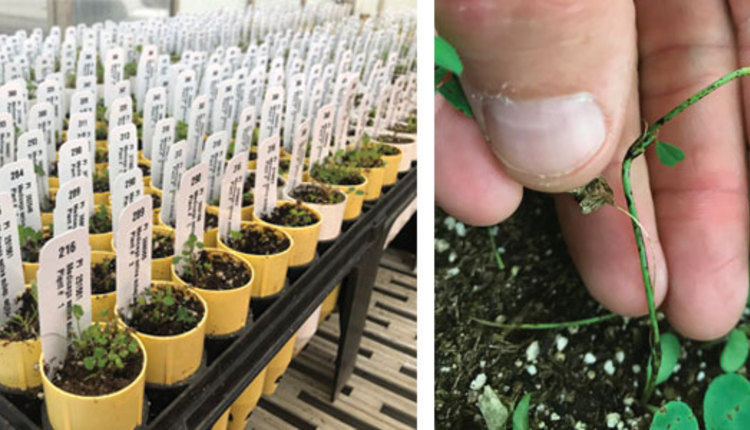Hay & Forage Grower is featuring results of research projects funded through the Alfalfa Checkoff, officially named the U.S. Alfalfa Farmer Research Initiative, administered by National Alfalfa & Forage Alliance (NAFA). The checkoff program facilitates farmer-funded research.

Researchers could be one step closer to finding ways to combat spring black stem and leaf spot (SBS), a fungal disease that reduces quality and yield in alfalfa. Recent Alfalfa Checkoff-funded research may give alfalfa breeders more information to develop cultivars with improved resistance to SBS. But that’s a bit down the road, says Brian Irish, the geneticist conducting the work. Irish is with the Agricultural Research Service Plant Germplasm Introduction Testing and Research Unit in Prosser, Wash.
Irish had heard alfalfa industry representatives discussing the disease, which causes severe defoliation and crop losses, especially in alfalfa spring growth. It is a problem particularly in the Midwest but can also be found in other regions with cool, wet weather early in the year.
Few modern alfalfa cultivars show more than moderate resistance to SBS, according to Deborah Samac, an ARS-USDA research plant pathologist collaborating with Irish on this project. Fungicide control options are effective but do not always have a positive return on investment, and if farmers harvest alfalfa early where disease pressure is severe, they potentially reduce yield, Irish added.
“So my ears perked up about this being an important plant pathogen of alfalfa for which better management strategies were needed, and the best way to manage any disease, in my opinion, is by innate plant disease resistance incorporated into the crop,” he said.
With Checkoff funding, Irish and his team hoped to find enhanced sources of resistance to SBS by performing disease reaction screening experiments. But first, there were hurdles to face.
The standard test inoculation protocol developed to screen alfalfa for disease reaction and selection wasn’t working out. “The procedure as followed didn’t produce the right outcomes, so we had to optimize it – play around with it,” Irish said.
By significantly reducing the concentration of fungal spores applied to plants, the researchers could distinguish differences between moderately resistant and susceptible cultivars.
The standard check cultivar Lahontan will be recommended as a susceptible reference. “Lahontan melts when we inoculate with this disease; it just does not like it and is very susceptible,” the researcher said. Other standard check cultivars showed improved resistance, but more than 14,000 plants of 79 different cultivars had to be screened in replicated greenhouse trials. “We identified several cultivars that were more resistant than the suggested moderately resistant reference. When we propose modifications to the test protocol, we will suggest the use of more resistant materials as references,” he said.
Power in numbers
A total of 189 lines or accessions corresponding to 68 different species in the Medicago genus, considered related to alfalfa (Medicago sativa), were also screened. “The idea was, if we screen through many different species that are related to alfalfa, we might find sources of disease resistance that we don’t find in the M. sativa pool. It is possible that other alfalfa-related species have disease resistance that can be bred into alfalfa,” Irish said. “These evaluations were also carried out in replications – multiple lines repeated to strengthen the evidence of findings. We did find that several of these species were considerably more resistant, even when compared to the best-performing alfalfa we found.”
Finally, in a “most laborious process,” said Irish, a large group of alfalfa germplasm was systematically screened for disease resistance to SBS. More than 2,800 unique alfalfa germplasm lines from the National Plant Germplasm System were screened for SBS resistance in non-replicated trials.
“Many of the lines screened outperformed the moderately resistant standard check cultivars, particularly when they originated from cooler regions of the world and environments,” he said.
In continued research, Irish and his team have made selections and plan to continue to breed the materials found to be disease resistant. “We are going to perform directed crosses, and we will screen progeny for disease reaction to try to improve resistance further. This improved germplasm will eventually be released and made available to the public,” he added. “I know some in the breeding community are interested in what we are doing. They could approach us about screening some of their advanced lines, or we could just demonstrate the modifications and show them how to implement the protocol.”

Project results
- Optimized inoculation protocols for fungal species causing SBS in alfalfa were developed.
- Standard check cultivars were evaluated, a few showed increased resistance, and a substitute reference cultivar(s) will be proposed. A large number of disease-resistant plants were selected for improved SBS disease resistant population development.
- Alfalfa relatives were screened for disease reaction to SBS and several were found to be more resistant than the moderately resistant reference cultivars.
- More than 2,800 alfalfa germplasm lines were screened for SBS disease reaction and a large group of plants were selected for their low disease reaction rating and for improvement.
This article appeared in the April/May 2021 issue of Hay & Forage Grower on pages 26 and 27.
Not a subscriber? Click to get the print magazine.

